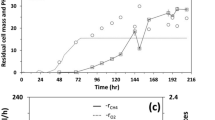Summary
Cells of Pseudomonas acidovorans strain CA28 capable of degrading aniline, 3-chloroaniline (3-CA), and 4-chloroaniline (4-CA) were immobilized in 1.5% (w/v) calcium alginate and cultivated in a special air-lift fermentor. For 6 weeks the fermentor was run as a chemostat with 3-CA (850 to 1166 μmol·l−1) as the sole source of carbon, nitrogen, and energy at dilution rates up to 0.297 h−1, which resulted in complete mineralization of the chloroaniline. Effects of aniline, monochloroanilines, 2,6-dichloroaniline, 3,4-dichloroaniline, fructose and acetate on the continuous degradation of 3-CA were estimated by single addition of these substrates to the fermentor. Fructose and acetate were metabolized without affecting 3-CA degradation, whereas addition of aniline derivatives resulted in a reversible decrease of the 3-CA degradation rate and thus intermediate accumulation of 3-CA in the fermentor.
Similar content being viewed by others
References
Bettmann H, Rehm HJ (1984) Degradation of phenol by polymer entrapped microorganisms. Appl Microbiol Biotechnol 20:285–290
Bettmann H, Rehm HJ (1985) Continuous degradation of phenol(s) by Pseudomonas putida P8 entrapped in polyacrylamide-hydrazide. Appl Microbiol Biotechnol 22:389–393
Beunink J, Rehm H-J (1988) Synchronous anaerobic and aerobic degradation of DDT by an immobilized mixed culture system. Appl Microbiol Biotechnol 29:72–80
Bisping B, Rehm HJ (1988) Multistep reactions with immobilized microorganisms. Biotechnol Appl Biochem 10:87–98
Cheetham PSJ, Blunt KW, Bucke C (1979) Physical studies on cell immobilization using calcium alginate cells. Biotechnol Bioeng 21:2155–2168
Dwyer DF, Krumme ML, Boyd SA, Tiedje JM (1986) Kinetics of phenol biodegradation by an immobilized methanogenic consortium. Appl Environ Microbiol 52:345–351
Ebbert K, Ederer H (1984) Computeranwendungen in der Chemie. 2nd edn. VCH, Weinheim
Johansen A, Flink JM (1986) A new principle for immobilized yeast reactors based on internal gelation of alginate. Biotechnol Lett 8:121–126
Kaufman DD, Blake J (1973) Microbial degradation of several acetamide, acylanilide, carbamate, toluidine and urea pesticides. Soil Biol Biochem 5:297–308
Kennedy JF, Cabral JMS (1983) Immobilizing living cells and their applications. Appl Biochem Bioeng 4:189–280
Keweloh H, Heipieper H-J, Rehm H-J (1989) Protection of bacteria against toxicity of phenol by immobilization in calcium alginate. Appl Microbiol Biotechnol 31:383–389
Latorre J, Reineke W, Knackmuss H-J (1984) Microbial metabolism of chloroanilines: enhanced evolution by natural genetic exhange. Arch Microbiol 140:159–165
Loidl M (1989) Abbau von Anilin und Chloranilinen durch bodenbürtige Pseuomonas acidovorans Stämme. PhD thesis, Technical University of Vienna
Loidl M, Hinteregger Ch, Ditzelmüller G, Ferschl A, Streichsbier F (1990) Degradation of aniline and monochlorinated anilines by soil-born Pseudomonas acidovorans strains. Arch Microbiol 155:56–61
Müller R, Haug S, Eberspächer J, Lingens F (1977) Catechol-2,3-Dioxygenase aus Pyrazon-abbauenden Bakterien. Hoppe Seyler's Z Physiol Chem 358:787–805
O'Reilly KT, Crawford RL (1989) Kinetics of p-cresol degradation by an immobilized Pseudomonas sp. Appl Environ Microbiol 55:866–870
Pfarl Ch, Ditzelmüller G, Loidl M, Streichsbier F (1990) Microbial degradation of xenobiotic compounds in soil columns. FEMS Microbiol Ecol 73:255–262
Rehg T, Dorger C, Chau PC (1986) Application of an atomizer in producing small alginate gel beads for cell immobilization. Biotechnol Lett 8:111–114
Sahasrabudhe SR, Amin AR, Modi VV (1985) Transformation of chlorinated benzoates and other benzene derivatives by Aspergillus niger and Aspergillus japonicus. Appl Microbiol Biotechnol 21:365–367
Sahasrabudhe SR, Modi AJ, Modi VV (1988) Dehalogenation of 3-chlorobenzoate by immobilied Pseudomonas sp. B13 cells. Biotechnol Bioeng 31:889–893
Surovtseva EG, Ivoilov VS, Karasevich YN, Vacieva GK (1985) Chlorinated anilines, a source of carbon, nitrogen, and energy for Pseudomonas diminuta. Microbiol 54:756–760
Westmeier F, Rehm H-J (1985) Biodegradation of 4-chlorophenol by entrapped Alcaligenes sp. A7–2. Appl Microbiol Biotechnol 22:301–305
Westmeier F, Rehm H-J (1987) Degradation of 4-chlorophenol in municipal wastewater by adsorptive immobilized Alcaligenes sp. A7–2. Appl Microbiol Biotechnol 26:78–83
Zeyer J, Kearney PC (1982) Microbial degradation of para-chloroaniline as sole carbon and nitrogen source. Pestic Biochem Physiol 17:215–223
Zeyer J, Wasserfallen A, Timmis KN (1985) Microbial mineralization of ring-substituted anilines through an ortho-cleavage pathway. Appl Environ Microbiol 50:447–453
Author information
Authors and Affiliations
Additional information
Offprint requests to: F. Streichsbier
Rights and permissions
About this article
Cite this article
Ferschl, A., Loidl, M., Ditzelmüller, G. et al. Continuous degradation of 3-chloroaniline by calcium-alginate-entrapped cells of Pseudomonas acidovorans CA28: influence of additional substrates. Appl Microbiol Biotechnol 35, 544–550 (1991). https://doi.org/10.1007/BF00169766
Received:
Accepted:
Issue Date:
DOI: https://doi.org/10.1007/BF00169766




